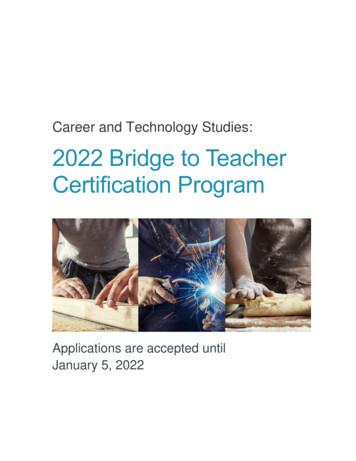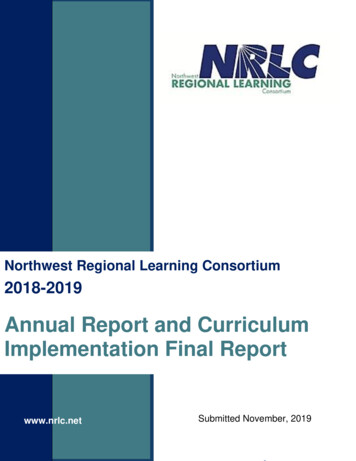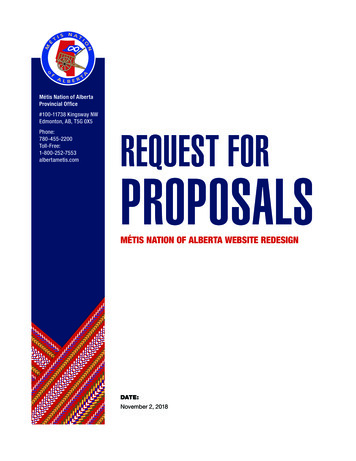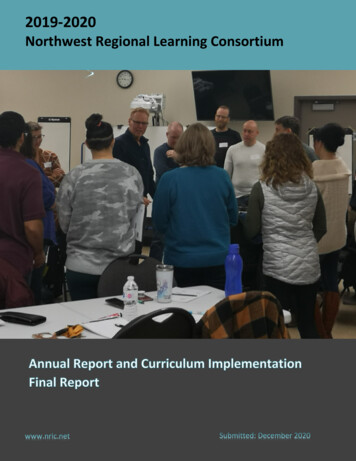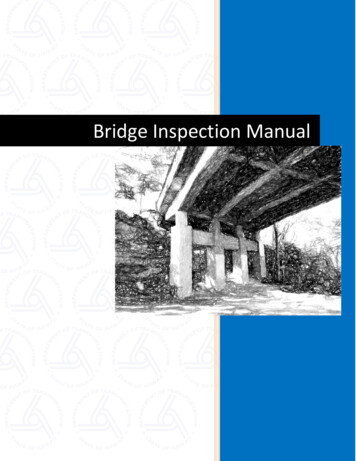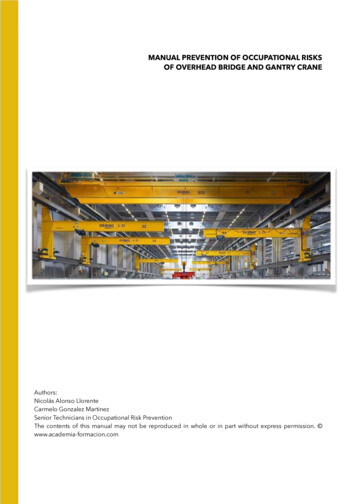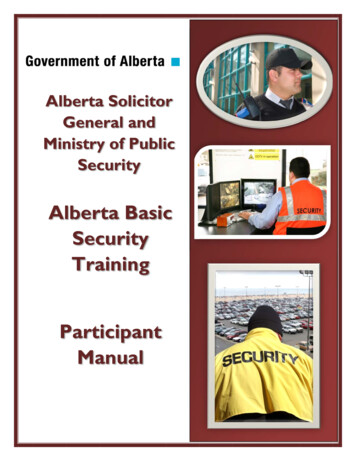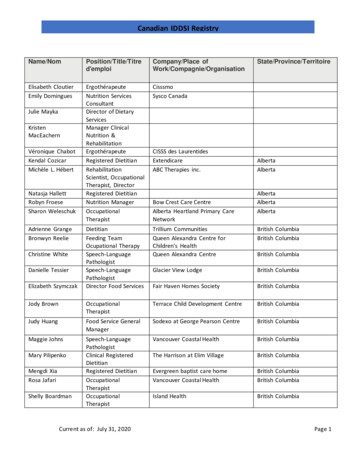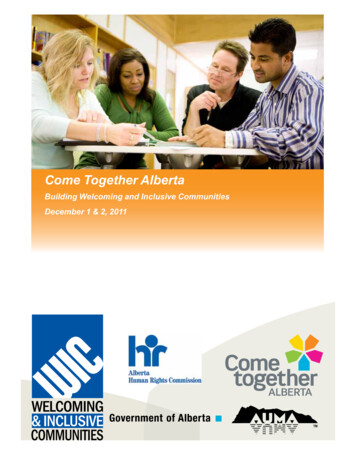
Transcription
NEWSLETTER OF THE YOGAASSOCIATION OF ALBERTAYOGASPRING 2017 VOLUME 17 ISSUE 2BRIDGECONNECTING MIND & BODYSPRING 2017 VOLUME 17 ISSUE 21
YAA EXECUTIVEPresidentDavid McAmmondPast-PresidentAnita SieleckiVice-PresidentKaren HamdonSecretaryDavid MaulsbyTreasurerErin MichieCalgary Member-at-Large (MAL)Jodi Hope-JohnstoneEdmonton MALKaren KirkwoodLethbridge MALVal KunimotoRed Deer MALPaula Carnegie Fehr, Ann WaschukThe Yoga Association of Alberta is a non-profit organization offeringyoga activities to the public for the purpose of providing selfdevelopment opportunities to Albertans through its own activitiesand in cooperation with groups practising all recognized yogadisciplines. Support is provided to members and local groupsthrough: Providing information about current and future yoga activities inAlberta. Publication of a regular newsletter, Yoga Bridge. Promoting and maintaining high standards of yoga instructionthrough a teacher training and certification program. Organizing workshops, retreats and other activities independentlyand in co-operation with individuals and yoga communitiesthroughout the province.The Yoga Bridge Newsletteris published by:The Yoga Association of AlbertaPercy Page Centre, 11759 - Groat RoadEdmonton, AB T5M 3K6Tel: (780) 427-8776; Fax: (780) 422-2663E-mail: yaa@yoga.caWebsite: www.yoga.caEditor:Marcia LangenbergEditorial Board:Judith MirusCorinne MilroyAnita SieleckiDebbie SpenceLayout and DesignDebbie SpenceFunding:The Y.A.A. gratefully acknowledgesfinancial support from the AlbertaGovernment and Active Alberta. Serving marginalized populations including prisons, street youth,women’s shelters, seniors and rural communities through anOutreach Karma Yoga Program.Editorial Policy: The opinions expressed are not necessarilythose of the YAA or the editorial board and different views maybe presented in other issues. The material in this newsletter is notintended as medical advice. Consult a medical or health professionalon any health or safety issue. The YAA does not favour, promoteor recommend any particular method, teacher or yoga disciplinerepresented in this newsletter. The YAA is not responsible forinformation contained in articles or advertisements or for ensuringqualifications of advertisers or writers. All submitted articles shouldbe the original work of the author. Submitted articles must not appearin print or any other publication medium prior to publication in theYoga Bridge.The YAA editorial board reserves the right to copy-edit and condenseall articles being published. Any substantive changes will bemade in consultation with the author and in view of publicationdeadlines. Those wishing to submit articles should consult theYAA Newsletter Submission Guidelines for Contributors at www.yoga.ca. All submissions, whether solicited or not, are reviewedaccording to these guidelines. We do not include promotionalinformation in published articles. The YAA is in no way responsiblefor advertisements or calendar entries that are submitted but notincluded in the newsletter.2Yoga BridgeCopyright Policy: Duplication of YAA material in other journals/newsletters may be approved subject to notification of or consultationwith the editor or YAA Executive Director. Do not re-publish withoutpermission.Circulation: 1,900ADVERTISING RATES(Measurements:width by height )B/W ColourEighth Page (3.0”x 2.0”)75.00 110.00Quarter Page (3.0”x 3.75”)100.00 140.00Half Page (6.25”x 3.75”)130.00 200.00Full Page (6.25”x 7.75”)200.00 300.00Inside Covers 350.00Please e-mail advertisements in highresolution PDF format, CMYK for colour ads.Additional charge for typesetting, formattingor editing ads. The YAA reserves the right torefuse ads that are not in readable format orthat do not contain appropriate content.Advertising Deadlines (3 issues/year):March 1, August 1 and November 1.Article Submission Deadlines: Call YAA.Newsletter circulation is approximatelyone month after deadline.Spring 20173
Outgoing Editor’s Message: Communal EffortCONTENTSMarcia Langenberg, EditorOutgoing Editor’s MessageMarcia Langenberg5Yoga Bridge Issues (2015-2016)Marcia Langenberg7BodySensingKirsten Ross11The Journey of Mindfulness into the Public Eye Anita Sielecki15The iRest Program for Healing PTSDby Richard Millerbook review Jodi Ouelette17Meditation Using Natural WisdomKavindu19Why Yoga Instructors Should Have Insurance Toole Peet & Co. Ltd.30YAA Interview with Donna MartinGaye Oxford31Directory of Alberta Teachers 201737ALBERTA Calendar of Events41YAA Yoga Props48What isYogaChi?Hatha YogaWORKSHOPYogaChi is Physical, Intellectualand Meditative Quests in HumanLife: Physical Quest: The supremacyof this exercise system forattaining and maintaining goodhealth is discussed in theoryand in practice. Intellectual Quest: YogaChiasserts an “open system” toprime one’s “Intelligence”. Thisis discussed. Meditative Quest:“Intelligence” is that “MysticalSovereignty” of who each oneis. This is discussed.November 4, 2017Hatha Yoga & YogaChiw/ Paul YappPercy Page Centre, EdmontonRoom # 7, 40; 9:30-2:30 pm YogaChi - discussion of physical,intellectual and meditative Questsin Life. YogaChi Exercise with SunSalutation (YChi version). Techniques balancing internalexternal rotation of legs and eaglepostures. Meditation practice: visualizationand concentration.Jamie Platz YMCA, 780-481-9622Sunday, 12:45 - 1:45 pmWorld Health ClubKensington:Thursday 7:30 pm - 8:30 pmSt. Albert Trail:Sunday 11am - 12noonClairviewWednesday 9:30 - 10:30 amWestmount Fitness CentreThursday 6 - 7 pmAvailable to teach at Governmentor Corporate locations.Group or Private classes.Alberta Human Resources, Lo-Se-CaAlberta Restorative JusticePaul Yapp EET, B.Sc., BA, RMT, YAA Certified, Tai Chi Teacher, Founder YogaChiRegistered Massage Therapist; Member NHPC780 288 3388; n/home#!classes4Yoga BridgeIn the following quote, English writer TedHughes (1930-98) identifies both the essenceand one of the challenges of attempting tocompose a cohesive, comprehensive andclear piece of writing: all our experience of life: the actualsubstance of it, the material facts of it, embedthemselves in us quite a long way from theworld of words. It is when we set out tofind words for some seemingly quite simpleexperience that we begin to realize what ahuge gap there is between ourunderstanding of what happensaround us and inside us, and thewords we have at our command tosay something about it.Words are tools, learned late andlaboriously and easily forgotten,with which we try to give some partof our experience a more or lesspermanent shape outside ourselves.They are unnatural, in a way, and Marcia Langenbergfar from being ideal for the job.1Although it may be difficult to find wordsthat accurately express knowledge acquiredthrough both experience and the study ofyoga texts, contributors to the Yoga Bridgehave effectively shared their understandingwith the newsletter’s readers. They havefound specific words that succinctlyrepresent what they are trying to say. Theyhave used compositional elements suchas text structures (description, sequence,problem/solution, etc.) to organize theirideas and literary devices (anecdotes,analogies, quotes, etc.) to create images oftheir ideas. They have willingly followedthe feedback from the editorial boardto revise their writing when required.Furthermore, as a result of their diversebackgrounds, a breadth of topics has beencovered over the years. The article “YogaBridge Issues 2015-16, Scope of Articles”published in this issue, gives examplesof the variety of topics writers havecompetently addressed.During the last four years as editor ofthe Yoga Bridge, I appreciated the time andeffort the writers dedicated to composinga story about their yoga knowledge,practice and experience. I wasgrateful for the editorial boardmembers’ insightful feedbackabout each of the submissionsand the newsletter readers’helpful feedback about thelayout, design and content of thenewsletter. Always, the intentwas to create the best form andexpression of the ideas from manydifferent points of view and in ameaningful way. I was inspiredand enriched by this collegialgroup effort of the writers, the editorialboard and the readers to achieve this goal.As the well-known African proverb says,“It takes a village to raise a child.” So, too,does it take a communal effort on the partof yoga teachers and practitioners fromdiverse backgrounds to work together tonurture a comprehensive understandingof yoga. I wish to thank all of the writers,editorial board members and readers forthis opportunity to work together to deepenand broaden the understanding of yoga.This cooperation is a practice of yoga, whichby definition, means union, clarity, harmonyand balance.2Spring 20175
Although it is with some sadness thatI take leave of the position of editor as Imove into another stage of my life, it iswith confidence that I turn over the positionto Norm Cowley, an editor with years ofexperience. From working together throughthis transition period, he clearly fits in withthe collaborative working model and bringsa wealth of knowledge and experience tothe job. Thus, it is with knowing that theYoga Bridge will be in Norm’s well-qualifiedhands and under his leadership that I takeleave of the editor’s position.Endnotes:1 Hughes, Ted. “Words and Experience” inESSAYS Thought and Style by Brian Kellowand John Krisak2 Frans Moors, Liberating Isolation, TheYogasūtra of Patañjali.Experience the legacy of FRIEDEL KHATTAB’S teachings:Yoga of the Old Masters with YAA Senior TeachersYoga Bridge Issues 2015-2016Marcia Langenberg, EditorThe following is a snapshot of aspectsof yoga and complementary disciplines– ancient and modern texts, yoga andBuddhism, historic and contemporarymasters’, teachers’ and students’ lineages,Alberta visionaries, contemporary practices– which the writers referenced and/or discussed in their articles that werepublished in the Yoga Bridge 2015 and 2016issues. It is an image of the depth andbreadth of the ideas presented, the YAA’sconnection with national and internationalyoga community and the knowledge andexpertise of the writers. Thank you to all thewriters for sharing their own understandingand experience with the readers of the YogaBridge.The categories are arbitrary. They werecreated to acknowledge, at least once, someof the texts, teachers, students and practicesthat were discussed in the issues. Some ofthe people referenced have passed away,but their ideas are still relevant today. Thiscomprehensive list does not include theinformation that is in the advertisementsand calendar of events that also reflects thestudy of yoga.Before Common Era (BCE)Vedas: sacred canon of Hinduismcomprising of four hymnodies: Rig-Veda,Artharva-Veda, Yajur-Veda, Sāma-Veda.Ken Strachan: Yoga for Strength & BalanceDiane Smyth: Yoga of Dev Murti (Crocodile)Lawrence Dombro: PranayamaRose Bardoel: Hatha Yoga (Sivananda System)Edie Cassady: Yoga Therapy6Yoga BridgeTracy Garvey: Okido YogaLinda Dumont: Hatha for all levelsKaren Hamdon: Kaivalyadama YogaMary LeBlanc: Yoga FlowMelanie Jones: Friedel KhattabUpaniṣads: refinement of the spiritualteachings of the Vedas. Wisdom partrather than ritualistic part of the vedicheritage. Metaphysics expounded upon inthe Upaniṣads: advaita (nondual) vedānta(end of vedas – referring to the upaniṣads).The vedic concern is to help us understandour own nature and the truth of themysterious universe.Mahābhārata: great national epic or storyof the Bharatas, which was composed inSanskrit and in which reference are madeto yoga and Sāmkhya philosophy.Bhagavad Gītā: a book in an episode in theMahābhārata.Patañjali - Yoga Sūtra: compilation andsystematization of existing knowledge,which gave yoga a philosophical shapethat allowed it to compete with othercontemporary schools of thought.Common Era (CE)2nd Century: Mādhyamika (middle way) –central philosophy of Buddhism basedupon the works of Nāgārjuna.9th Century: Nathamuni’s Yoga Rahasya(Secrets of Yoga): Śrī Nāthamuni, aVaiśnavite Saint (worships viśna). T.Krishnamacharya is a direct descendentof Śrī Nāthamuni. He revived this text.11th Century: Vijñāna Bhairava Tantra - akey text of the Trika school of KashmirShaivism. The Radiance Sutras: 112Gateways to the Yoga of Wonder and Delight(2014) is a translation with commentary ofthis ancient text by Lorin Roche.13th Century: Mevlana Jalaluddin Rumi,Persian poet, Islamic scholar, theologian,Sufi mystic.14th Century: Haṭha Yoga Pradipikā (Light onYoga) by Svātmārāma Yogin.17th Century: Gheranda Samhitā byGheranda is modeled on Haṭha YogaPradipikā.Spring 20177
19th Century: Swami Vivekananda was thechief disciple of Hindu visionary RamaKrishna. Swami Vivekananda introducedHinduism at the Parliament of theWorld’s Religions in Chicago in 1893.20st-21st Century:Visionaries and Cultivators of Yoga inAlberta:Friedel Khattab (Edmonton) – establishedthe Friedel Khattab School of Yoga.Hilda Pezzaro (Calgary) – practised andtaught Iyengar yoga.Jean Bosworth (Edmonton) – 30-year careerteaching yoga.Dr. Hubert Dhanaraj (Edmonton), co-authorDr. Mohan Singh and L. K. Govindarajuluof Fitness Through Yoga, 4th Edition, 1992.Gerda Krebs (Sherwood Park) – producedand hosted “Yoga Fits In” on Shaw CableTV for over 25 years and is still involvedin training teachers.Grace Little (Innisfail) – “grandmother” ofCentral Alberta yoga.Isa Duxbury (Edmonton) – basic traditionalhaṭha yoga integrated with other physicalmovements.Bonnie Dunbar (Calgary) – Yoga teacheseach person to take care of his/her ownhealth. She knows instinctively that yogais a great medicine.Lineages:Swami Sivananda Saraswati was a Hinduspiritual teacher, a proponent of yoga andvedanta, and the guru of Swami SivanadaRadha. Swami Sivananda Radha wasthe founder and spiritual director of the8Yoga BridgeYasodhara Ashram in Kootenay Bay, B.C.T. Krishnamacarya (India) – T.K.V.Desikachar (India), Mary Lou Skelton(USA), Claude Marechal (Belgium),Rosemary Jeanes Antze (Toronto), MarciaLangenberg (Edmonton).Mahāmandaleshwara Swami Veda Bharati(Dr. Litt), scholar-saint and spiritualdirector of the Himalayan InternationalInstitute of Yoga Science and Philosophy,India – Maya Margo Balog (Edmonton),David Downing (Edmonton), Keely Scott(Edmonton), Pandit Hari Shankar Dabral(Calgary), Ginger Cunes (Calgary), Dr.Marian Jerry (Canmore) and Dr. MartinJerry (Canmore).B. K. S. Iyengar (India) – Judith Mirus &Teddy Hyndman (Edmonton), MargotKitchen (Calgary), Val Paape (Winnipeg).Contemporary Practices (developed in the20th Century CE)Dina Rodrigues (Brazil) – Hormone YogaTherapy founder.Gert van Leeuwen (Netherlands) – CriticalAlignment Yoga Therapy founder.Gary Kraftsow (USA) –American ViniyogaInstitute founder and director.Richard Miller (USA) - iRest (IntegrativeRestoration) Yoga Nidra Meditationfounder and co-founder of theInternational Association of YogaTherapists.Jon Kabat Zinn (USA) – Mindfulness BasedStress Reduction founder.Donna Martin (Kamloops) – Psoma YogaTherapy (integration of Hakomi, yogaand mindfulness) founder.SwamiNirmalandaSaraswati(a.k.a. RamaBerch) (USA) –Svaroopa Yoga(experience yourtrue nature,bliss) founder.Michael George(England) andDebbie Spence– teachers ofthe BrahmaKumarisThe Battlefieldspiritual path– rāja yoga, a form of meditation thatleads to clear self-awareness and personaltransformation.BooksHow to Know God: The Yoga Aphorisms ofPatañjali and The Song of God: BhagavadGita, translation and commentary bySwami Prabhavananda (USA) andChristopher Isherwood (USA), who arefrom the vedānta tradition.Yoga, Discipline of Freedom, the Yoga SūtraAttributed to Patañjali and The BhagavadGita, Krishna’s Counsel in Time of War,translation and commentary by BarbaraStoler Miller, a Sanskrit scholar inBarnard, Columbia Univ.Threads of Yoga: A Remix of Patanjali-s Sutra-s,with Commentary and Reverie, MatthewRemski (Toronto), yoga philosophy,meditation, Ayurveda and the socialpsychology of practice.The Yoga Sūtras of Patañjali, translation andcommentary by Edwin F. Bryant (USA),Rutgers University professor of Hindureligion and philosophy.Light on Yoga andLight on Life, B. K. S.Iyengar, guruji of TheRamamani IyengarMemorial YogaInstitute, Pune, India.Awakening the Spine,Vanda Scaravelli(Italy). Studied withB. K. S. Iyengar formany years.Heilkunst Yoga, Dr.Imoghen Dalmannand Dr. MartinSoder (Germany), students of T. K. V.Desikachar (India).Sounding Sanskrit, Vedic and TraditionalChants for Yoga, compiled by RosemaryJeanes Antze (Toronto), internationalsenior teacher and teacher trainer in thelineage of Krishnamacharya-Desikachar.The Bhagavad Gītā with Sanskrit Text,Translation and Comparative Commentaryand The Labyrinth of Solitude (meaning ofdharma based upon the Mahābhārata),Dr. K. D. Prithipaul (Edmonton),University of Alberta Professor EmeritusReligious Studies –Hinduism.From the Gita to the Grail: Exploring YogaStories and Western Myths, Bernie Clark(Vancouver), University of WaterlooBachelor Degree of Science and student /teacher of yoga, mythology, comparativereligions and psychology.The inner tradition of yoga: A guide to yogaphilosophy for the contemporary practitioner,Michael Stone (Toronto), yoga andBuddhist teacher and psychotherapist.Spring 20179
Awareness Alone is not Enough, Sayadaw UTejanya (Myanmar – formerly Burma),Buddhist monk and meditation teacher.blockages, increase in the flow of prānaand engagement of the intuitive aspectsof the mind.Satipatthana Sutta, The Direct Path toRealization, Bhante Analayo (Sri Lanka),Buddhist monk, scholar and meditationteacher.Graceful Exits: How Great Beings Die (Deathstories of Hindu, Tibetan Buddhist, andZen masters), Sushila Blackman (editor),student of the Hindu master SwamiMuktananda.Mindfulness in Plain English,VenerableBhante Henepola Gunaratana, founderof Bhavana Society, Back Creek, HighView, WV. Dedicated to the practice ofTheravadan Buddhist meditation, theoldest school of Buddhism. The Pali wordbhāvana means mental cultivation.Being Peace, Thich Nhat Hanh (France),Vietnamese Buddhist monk in exile,global spiritual leader, poet and peaceactivist.Yoga and the Quest for the True Self andThe Wisdom of Yoga, A Seeker’s Guide toExtraordinary Living, Stephen Cope (USA),psychotherapist and scholar-in-residenceand Kripalu yoga ambassador.Overcoming Trauma through Yoga: ReclaimingYour Body, David Emerson, director ofyoga services at the Trauma Centre at JRI,Brookline, MA and Elizabeth Hopper,clinical psychologist.Yoga Therapy for Backs: A PracticalGuide, David McAmmond (Calgary),international yoga teacher, YAApresident, with Anita Sielecki(Edmonton), retired University of Albertabiochemistry researcher, internationalyoga teacher, YAA past-president.Yoga Fiction, Yoga Truth – Book 1:Transmuting Wounds, Walking into yourSelf by Sandra Sammartino (White Rock),yoga teacher for over four decadesfocusing on the release of emotional10 Yoga BridgeYoga Body, Mark Singleton (USA), teaches atSt. John’s College, Santa Fe, New Mexico.Poems for Meditation, An Invitation to Prayer,Antoinette Voûte Roeder (Edmonton),poet, spiritual director and yoga student.Why I Wake Early, Mary Oliver (USA),Pulitzer Prize for poetry, 1984.FilmGurukulam - Sensing the Sacred:Experiencing Advaita Vedānta (oldestIndian philosophy of nondualism)by Neil Dalal, University of Albertaprofessor of South Asian Philosophy andReligious Thought with Jillian Elizabeth(Edmonton), American documentaryfilmmaker.Problems with sleep?Calm the omadvertisementBodySensing:Taking “Feel Your Body” To A Whole New LevelKirsten GuestNo doubt we have all attended, and likelytaught, yoga classes where we have heardor been given the instruction, “listen to yourbody.” This instruction sounds good and itmakes sense. After all, isn’t this attentionto the body what differentiates yoga āsanafrom other forms of physical movement?I clearly remember attending my firstyoga class nearly 30 years ago while livingin London, Ontario. I came home excitedto have found something completely new,something I had never experienced before.Every position, movement and form wasfamiliar to me from years of immersion inthe world of fitness. What was unique andnew was that I was invited over and overagain to “feel.” And that has made all thedifference.Little did I know that this new tool wouldtake me places I never knew existed.Fast forward 10 years and a re-locationto the East Kootenay region in BritishColumbia. As a new yoga teacher, Imirrored the words of my early teachers,instructing students to feel various bodyparts as they explored movements andpositions.After attending my first meditationretreat with Dr. Richard Miller in Hinton,this instruction began to radically change.Instead of just feeling a location of stretch,participants were invited to “feel the wholeleft arm as radiant sensation.” What? Icould feel my feet on the ground, but weweren’t even stretching an arm! How wasI supposed to feel this and, even moreimportantly, why?Invitations continue: feel the tongue, themouth, feel the insides of the ears, feel bothhands at once, feel the brain!I was lost. I was confused. I felt likethere must be something terribly wrong.Was everyone else able to follow theseinstructions? What was wrong with me?Invitations became subtler: feel thespace that surrounds the body, feel theceiling, the walls, feel inward and outwardsimultaneously.Are you kidding me? Now the real doubtbegan to creep in. Who was I, calling myselfa yoga teacher when I had no idea how toaccess what was being presented here? Andwhat difference was this to make to myyoga practice or to my students?And yet something piqued my curiosity.I returned to meditation retreats withMiller over and over again. Often confused,something kept drawing me back. Andsomething shifted, a doorway opened.It opened to a world that I didn’t knowexisted and yet it felt like it had been thereall along. I would love to say this shifthappened in a moment, but it didn’t. All Ican say is there came a time when I realizedthat I had access to feeling everywheresimultaneously: inside the body, outside thebody, whole body sections and whole bodyat once, as if this ability had always beenthere. I could no longer not feel everythingthat was being invited.Spring 201711
BodySensing is a practice of opening thecapacity to feel, using all of the senses, thewhole body inside and out, and even to feelthe limitless space that surrounds the body.BodySensing can be done in movementor in stillness. BodySensing is meditation,whether this is incorporated into your yogaasana, prananyama or practised duringseated or lying meditation.BodySensing isn’t limited to yoga. Thisis a skill that can infiltrate our entire day.Waking or sleeping, walking, swimmingand dancing can all become opportunities toexplore BodySensing. Peeling carrots, eatinga bowl of soup and making love all becomefurther explorations of BodySensing.With practice and time, the inherentawareness of sensation in the body becomesrestored. The borders and boundaries ofthe body dissolve. We begin to experienceourselves as vast, limitless space. Thenormal physicality that we take ourselvesto be opens up to a broader experience ofourselves as spacious, timeless, free fromrestrictions and limitation. We reconnectwith ourselves as integrated, whole,complete and perfect.Isn’t this the ultimate goal of any yogapractice – to feel this connection? This is thefinal understanding of all contemplativepractices; to know ourselves as “freedom”.BodySensing now oozes from my pores.When leading a BodySensing practice, I amalways amazed to hear what comes out ofmy mouth. Descriptions and instructionscan sometimes feel wild and far out, but theexperience always leads to this same senseof freedom and feeling of ease.Although most teaching of yoga isinfused with the instructions to “feel your12 Yoga Bridgebody,” BodySensing movement as I describeit here comes from the Kashmir non-dualtradition. I was introduced to this throughMiller, who learned the practice from JeanKlein, an Advaita Vedānta teacher who wasinfluenced by the teachings of KashmirShaivism.Whether you are mobile or not,experienced with yoga or not, BodySensingis a delicious practice that can open youto the freedom of all that you are and takeyour yoga and meditation practice to placesyou never expected.SUNDAYMAY28,201741st YAA ANNUAL GENERAL MEETING, EDMONTON& BodySensing Yoga - an iRest Yoga Nidra Meditationin Movement and Stillness with Kirsten Guest10 am-1:00 pm1:00 - 2:30 pmKirsten Guest will be presenting BodySensing atthe YAA-AGM - see details at right - page 13.Membership in the YAA is notlimited to teachers. Anyone wholoves yoga can join! 10 YAA Associate membership:Teachers, please encourage yourstudents to become members toreceive an electronic newsletter. 30 YAA Full membership: Teachersreceive mailed newsletters, and 1 coupon for every 25 propspurchased from the YAA store.THE YOGA ASSOCIATION OFALBERTA IS A PROVINCEWIDE YOGA ASSOCIATION,ESTABLISHED IN 1976.THE YOGA ASSOCIATION OFALBERTA IS YOUR ASSOCIATION!Fee:Location:Registration:iRest Yoga Nidra w/ Kirsten GuestYAA 41st Annual General Meeting & catered lunchElection Nominations: Members at Large (Karen Kirkwood,Erin Michie, Edmonton; Val Kunimoto, Lethbridge; JodiHope-Johnstone, Calgary; Ann Waschuk, Red Deer; PaulaCarnegie Fehr, Red Deer. 30 ( 10 non-members)Kenilworth Community Hall 7104-87 AvenueYAA (780) 427-8776; yaa@yoga.caAs yoga teachers (and students), we often invite our students to “feel theirbodies”, or “listen to their bodies.”. Through guided movement practices duringthis workshop, you will be invited to step into this instruction in a way you havenever experienced before. Kirsten Guest will immerse you in this exquisite practisethat incorporates the final culmination of all meditation practices - to find completefreedom of body, mind and soul. The session will include practical suggestions onhow to incorporate this moving meditation into your teaching, or practice of any styleof yoga. Come prepared to “fly”. See article page 11.Kirsten Guest is an E-RYT 500 yoga and meditation teacher with20 years of teaching and playing in the field of yogic teachings. Sheis a Supervisor and Mentor of iRest yoga nidra meditation teachersand the Director of Teacher Certification for the IntegrativeRestoration Institute (www.irest.us). The Institute was founded byRichard C. Miller PhD, current author of the meditation column ofYoga Journal, and author of Yoga Nidra and iRest for PTSD (bookreview p. 17). Kirsten teaches yoga and meditation classes in herhome town of Kimberley, B.C., and travels to lead iRest retreats inthe nondual tradition throughout the U.S. and Canada.Spring 201713
The Journey of Mindfulness into the Public EyeHOSTED BY THE YOGA ASSOCIATION OF ALBERTA*** INTERNATIONAL YOGA DAY ***SATURDAY JUNE 17HAWRELAK PARK PICNIC SITE #4Noon-2 PMPlease join us and experience Yoga and Meditation taught by some of Alberta’sexperienced Yoga Teachers. Breathe and relax with yoga in the fresh summer air!Bring your family, friends & your mat!! ALL WELCOME. (Weather permitting)FREE ADMISSION FREE SNACKSINFORMATION: YAA 780-427-8776 yaa@yoga.caThis event is being held in celebration of INTERNATIONAL YOGA DAY (June 21)as declared by the United Nations.Anita SieleckiEven though yoga and meditation havebecome mainstream terms in the 21stcentury, they were often not mentioned inthe regular media as recently as 25 yearsago.That started to change after Bill Moyersproduced a ground-breaking program,Healing and the Mind, for the PublicBroadcasting Service (PBS) in the UnitedStates in 1993. The second of the five-partseries featured courses developed andtaught by Jon Kabat-Zinn, founder of theStress Reduction Clinic at the University ofMassachusetts Medical School.Kabat-Zinn was not a medical doctor; histraining was in biochemistry and molecularbiology. His patients were suffering froma variety of conditions – from unbearablechronic pain to anxiety and depression –and were referred to his clinic by medicalcolleagues because traditional medicine hadbeen unable to help.Kabat-Zinn emphasized his sciencebackground so he wouldn’t alienate hissuperiors, but relied upon his personalpractice of haṭha yoga, meditation andBuddhist philosophy to try to bring hopeand relief to the participants. The unusualand alternative methodology often broughtpositive, life-changing and enduring resultsas documented in the television program,which was shot over an eight-week periodin the basement of the UMass hospital.As the Stress Reduction Clinic programbecame more popular and accepted, itsphilosophical roots became less threateningto the medical community and its14 Yoga Bridgename evolved to reflect its background:mindfulness-based stress reduction program(MBSR). Nowadays it is taught widely andused in medical centres, hospitals and healthmaintenance organizations throughout theworld.Kabat-Zinn was determined to maintainthe purity of the teachings while presentingthem in a secular and modern framework.In teaching meditation, he emphasizes themindfulness component that he definesthese days as: “Mindfulness is awarenessthat arises through paying attention, onpurpose, in the present moment, nonjudgmentally. It’s about knowing whatis on your mind . in the service of selfunderstanding and wisdom.”The original roots of this contemporaryformulation can be traced back to Patañjali’sancient Yoga Sūtra. The definition of Yogain Sūtra 2 of Book I (according to T.K.V.Desikachar translation and interpretation inThe Heart of Yoga) is:Sūtra 1.2: “Yoga is the ability to directthe mind exclusively toward an objectand sustain that direction without anydistractions.”This relates directly to the first sentencein Kabat-Zinn’s definition of mindfulnesswhen the “object” of attention is the
9th Century: Nathamuni's Yoga Rahasya (Secrets of Yoga): Śrī Nāthamuni, a Vaiśnavite Saint (worships vinaś). T. Krishnamacharya is a direct descendent of Śrī Nāthamuni. He revived this text. 11th Century: Vijñāna Bhairava Tantra - a key text of the Trika school of Kashmir Shaivism. The Radiance Sutras: 112
